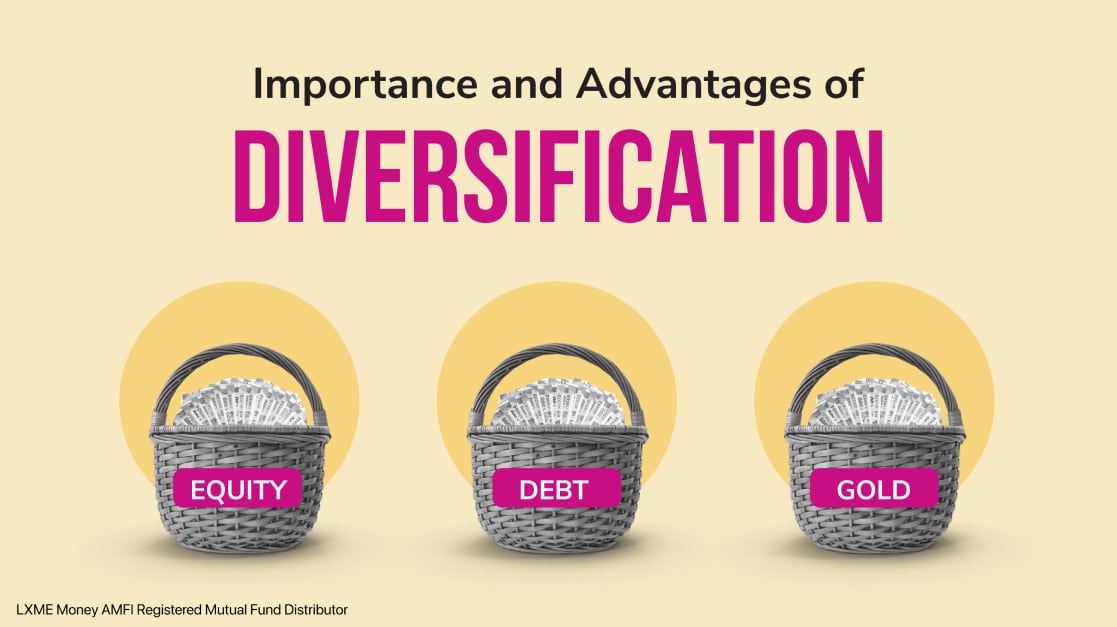As women, we love having options to choose from! Whether it’s in saree design or in our investment options. We know that it is important for a woman to invest her money to lead a financially secure life, but it is equally important for her to spread her investments across different types of investments to optimize her returns and balance her risks.
In this blog, let’s have a look at the importance and benefits of portfolio diversification
What is Portfolio Diversification?
Portfolio Diversification is a way to manage risk by spreading your investments across multiple asset classes such as equity, debt, gold, and fixed-income instruments. It is a form of risk management and it helps to ensure that there is a good balance between risk and returns in your portfolio.
How to diversify your portfolio?
One way to diversify your portfolio is to follow the 100-Age Asset Allocation Rule. According to this rule, you subtract your age from 100 and allocate that percentage toward equity. The remaining percentage can be allocated to other investment options like gold, debt mutual funds, and fixed-income instruments. However, ideally one should invest 5-10% of their portfolio in gold.
Example –
Ekta is 25 years old and she is ready to invest ₹10,000 monthly. To diversify her portfolio, she uses the 100-age rule. So, as per the rule, she will invest 75% (100-25 = 75)of her money i.e. 7,500 (10,000*75%) into Equity, 10% invested in a gold mutual fund, and the rest 20% invested in a debt mutual fund and fixed income instruments.
Importance of portfolio diversification
Here the popular phrase ‘don’t put all your eggs in one basket’ holds true that one should not invest all their money in a single investment option. Diversification is necessary to keep in check your overall risk level and keep your money secure. For example – If you are investing in Equity Mutual Funds, which are riskier when compared to other investment options, then you can balance your portfolio with other instruments. You can invest in Gold to protect your investments against inflation, debt to maintain stability, and fixed income instruments to get fixed returns.
Diversify your portfolio across equity, debt, and gold with mutual funds that too just Rs. 100 by investing in Lxme’s expert-curated portfolios now!
Now let’s have a look at the benefits and advantages of portfolio diversification
Benefits of portfolio diversification
Reduces Risk –
Diversification spreads your risk across different investments. So, if you are over-concentrated in one asset class, diversification helps lower the impact of unfavourable events on your portfolio by spreading your investments in multiple asset classes.
Optimized Return:
The returns procured are on average profits as the risk gets diversified, the return is comparatively higher than just investing in a single instrument.
Aids in tax planning:
Some investments may help us get tax benefits. Eg: If the MF is an equity-linked saving scheme (ELSS) or the FD is a tax saving FD, investments are eligible for tax deduction under section 80C of the Income Tax Act.
Protects against fluctuations –
It can provide safety from market fluctuations during times of economic distress as some investments in your portfolio will protect you from losses incurred in other investments.
Provides Long-Term Benefits –
Diversification is a good tool to grow your money in the long term. By investing in different asset classes, the power of compounding can give you great returns in the long run.
Peace of Mind –
A diversified portfolio allows you to feel secure in your investments as your money is in multiple instruments and not tied to one investment.
Diversification can be understood by the popular phrase ‘don’t put all your eggs in one basket’. By not being overexposed to one single investment, women can feel confident.
Check out this blog if you want to know how to build a strong portfolio
In conclusion, women should first assess their goal, time horizon and risk appetite, basis these parameters you can choose to invest in various asset classes and diversify their portfolio.
If this sounds too complex, Lxme’s here to make this process simple! You can start investing with Lxme’s diversified portfolios which are well-researched and curated by experts.
Check out the ‘invest tab’ and explore the time and goal-based portfolios.
FAQ’s
How much percentage should one allocate towards gold?
Ideally, one can allocate 5%-10% of their portfolio towards gold.
What should you consider while diversifying your portfolio?
While diversifying your portfolio, you should keep in mind your investment goals and risk appetite and accordingly, conduct proper research before investing.
Share this blog with your family and friends if you find it insightful!!
Download the Lxme app for more such content!
New Investor? Request a Callback.
Fill in your details and we will guide you at every step
other blogs

Mutual Funds July 30, 2024
Smart Emergency Fund Investment: Building Financial Security
Welcome to our comprehensive guide on Emergency Fund Investment. In today’s unpredictable world, having a financial safety net is paramount. In this article, we’ll delve into the art of smart money management, helping you understand the best strategies for emergency fund investment and cover all the importance of emergency fund. Discover how to make your … Smart Emergency Fund Investment: Building Financial Security

Mutual Funds Saving July 29, 2024
7 Reasons Women Should Have Emergency Savings
Ladies, here’s a questionnaire for you: What would you do in case of a medical emergency? Ask for money from friends or put it on the credit card? What would you do if your company didn’t give you a maternity leave? Leave the job or keep working & stressing? What would you do if your … 7 Reasons Women Should Have Emergency Savings

Mutual Funds Saving
A Simplified Guide To Financial Planning for Women In India
Welcome to our insightful guide on financial planning for women in India! At Lxme, we recognize the unique financial journey of women and provide a simplified approach to help you navigate through it. Discover empowering insights and expert advice on effective financial planning and investments tailored specifically for women. Let’s embark on this journey together … A Simplified Guide To Financial Planning for Women In India









